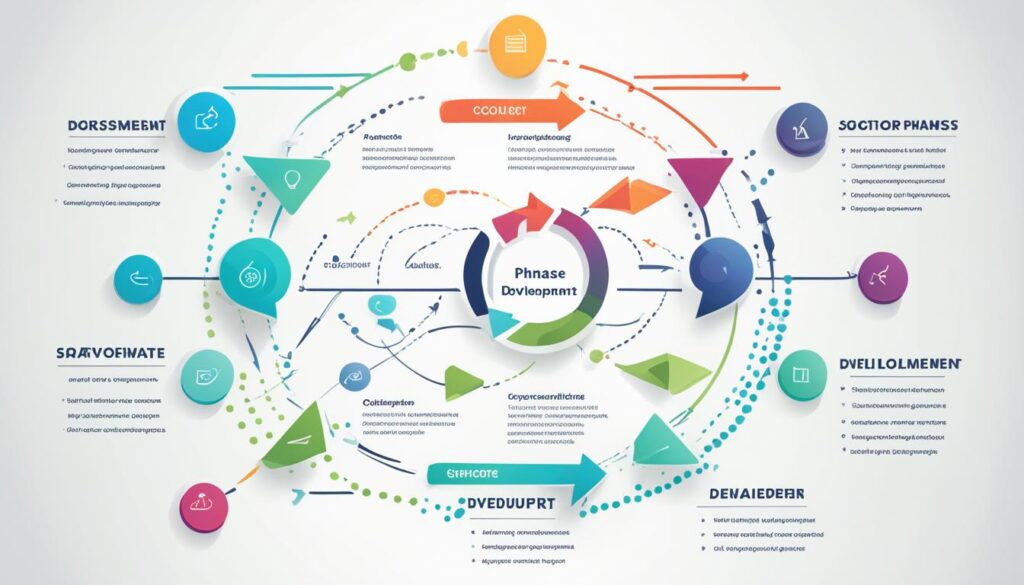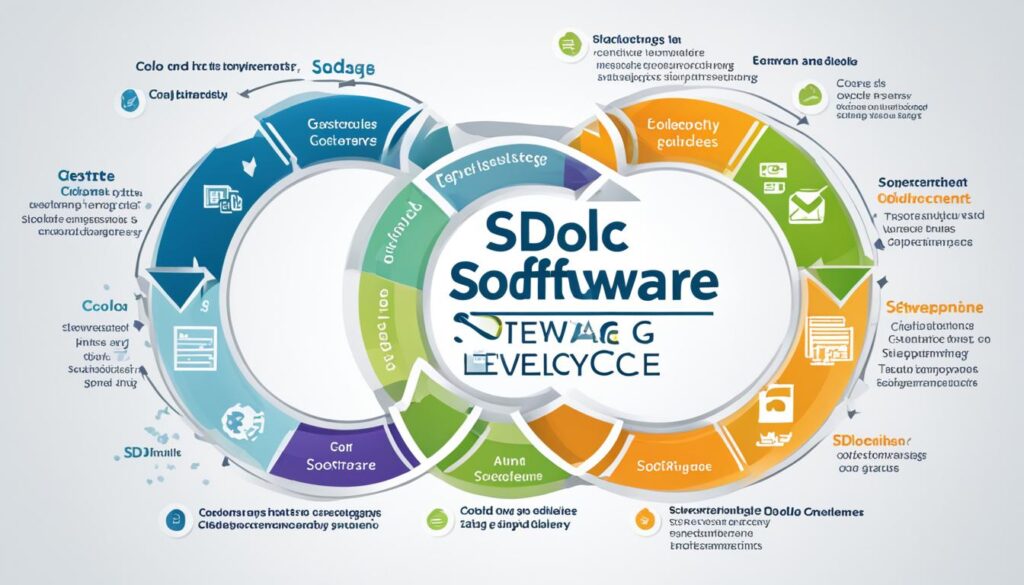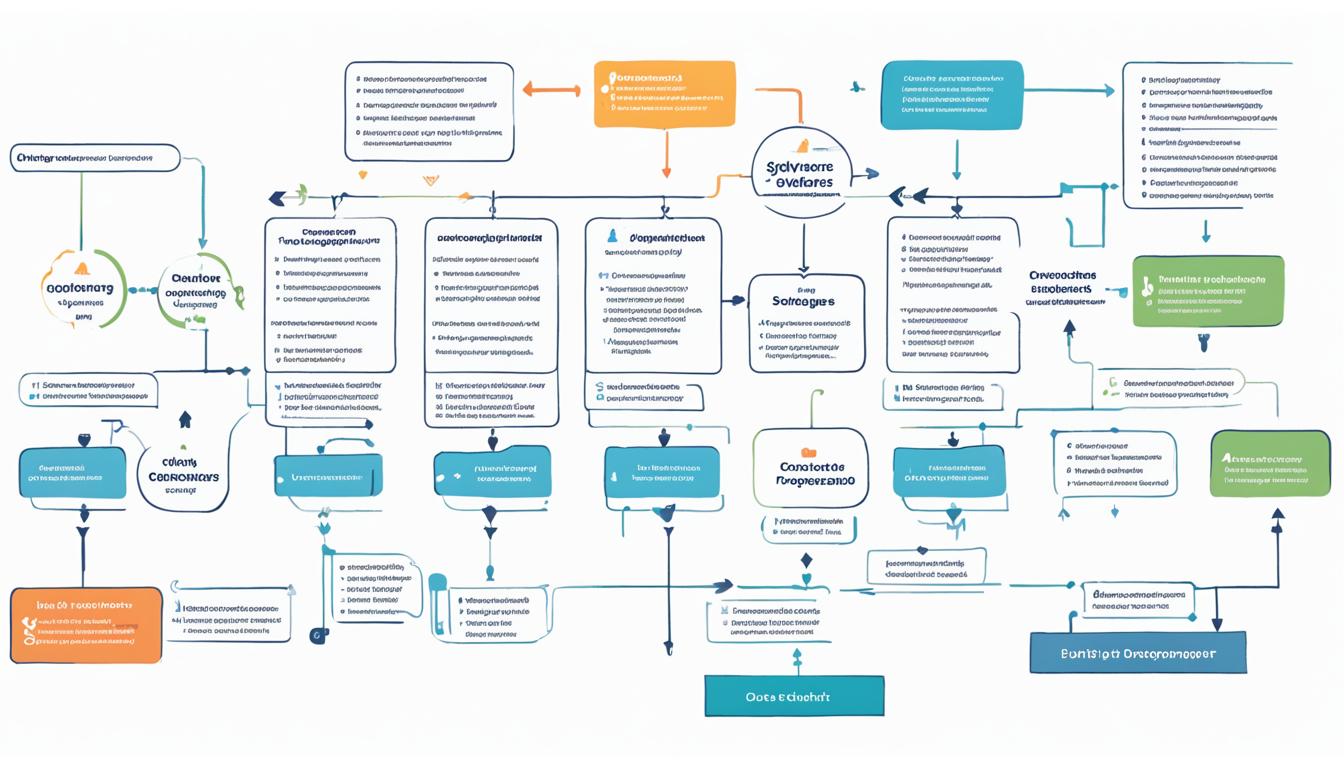The software development lifecycle (SDLC) is like building a sturdy, useful software, just as one constructs a home. With a detailed and step-by-step plan, this is achievable. Such an approach means the software fits what users need and can compete well in a global market. This market is expected to hit $165.3 billion in 2023.
The SDLC has several phases, starting from gathering what the software needs to do, all the way to its upkeep after it’s in use. This process ensures the software is of high quality. This guide will take you through the SDLC, helping you understand its parts, methods, and how to manage software projects well.
Key Takeaways
- The total revenue generated from software sales reached $165.3 billion in 2023.
- Experts predict that by 2027, the revenue from software sales will reach $217 billion.
- The SDLC phases are divided into a total of 8 stages.
- Reliable tools such as Visual Studio, IntelliJ IDEA, and Eclipse are essential in software development.
- Integration Testing is essential for verifying seamless integration between components and modules.
Introduction to Software Development Lifecycle (SDLC)
The Software Development Lifecycle (SDLC) is like a map for creating software. It guides the journey from brainstorming to finishing the product. This A Comprehensive Guide to Software Development Lifecycle shows how SDLC brings teams together. It helps them make great software on time.
Understanding SDLC’s many steps is key to working well with others. Sixty percent of software projects succeed when both inside and outside teams work together. This is most important at the start, where 85% of teams check if their project makes sense money-wise.
SDLC has several stages, like planning and testing, each very important. The design stage, for example, focuses on user interfaces. It also creates the software’s structure, setting a strong start for the project. This organized method keeps everything moving smoothly from start to finish.
Today, automation is a big part of SDLC. Around 70% of teams mix automatic and manual testing. This makes testing quicker and more precise. Also, having different setups for building and releasing software cuts down on breaks by 40%. This shows how a good plan can avoid many problems.
Following SDLC well not only makes software better but also keeps users happier. When organizations watch their system’s performance, they see a 25% jump in trust and satisfaction. This matches well with SDLC, which allows for updates throughout a product’s life.
In short, a strong start in SDLC teaches you about the whole process. It shows how to work together and test things right. This helps in leading successful software projects. It ensures the final product meets what customers and rules require.
| SDLC Aspect | Statistic |
|---|---|
| Cost-benefit analysis in planning phase | 85% |
| Collaboration of internal and external stakeholders for requirements gathering | 60% |
| Usage of automation alongside manual testing | 70% |
| Reduction in system downtime with separate build and production environments | 40% |
| Software maintenance tasks focused on bug fixes and addressing customer issues | 75% |
| Increase in software reliability with regular performance monitoring | 25% |
Phases of the Software Development Lifecycle (SDLC)
The Software Development Lifecycle (SDLC) has several key phases, all important for a project’s success. They help keep software creation on track and efficient. We’ll look at each phase to see what they’re about.
Requirements Gathering
Collecting project requirements is essential early on. The team works with stakeholders to gather what’s needed in detail. This ensures the software will do what users expect. Roughly 85% of teams spend 10-15% of their time here. Missing important details can cause project issues later.
Analysis
After gathering needs, the team analyzes them. They create a plan in a Software Requirement Specification (SRS) document. This step helps spot possible problems and set a clear path. It makes sure everyone is on the same page. A good analysis step can prevent risks.
Planning
Planning involves setting up budgets, schedules, and deciding who works on what. Projects that plan well have better success. Most software experts believe good planning is key. This phase also includes a detailed project plan with costs and timelines.
Design and Architecture
Then, software engineers start designing and planning. They decide on the framework and tools to use. They make a detailed plan, the Design Document Specification (DDS). This step is important for everything to work together fine.

Implementation and Coding
The team then turns plans into code. Coding takes up 30-40% of the project’s time. Teams keep track of daily progress. Fixing coding errors quickly is important to keep costs down. This phase is where the project begins to take shape.
Testing and Quality Assurance
Testing the software is crucial to find and fix problems. This phase can use up 25-35% of the budget but saves money later. Using various tests ensures the software is up to standard.
Deployment and Maintenance
After testing, the software is ready to go live. Good deployment strategies cut deployment time. Planning helps reduce errors live by 60%. Maintenance keeps the software updated and running well. Skipping this step leads to performance drops.
| SDLC Phase | Key Statistics |
|---|---|
| Requirements Gathering | 10-15% of timeline; 70% of delays due to inadequate gathering |
| Planning and Design | 20% higher success with proper planning; 90% architects prioritize careful design |
| Implementation (Coding) | 30-40% of effort; 20% rework cost increase if errors are not addressed |
| Testing | 25-35% of budget; early bug detection saves up to 80% in costs |
| Deployment | 50% time reduction with automation; 60% fewer issues with proper planning |
| Maintenance | 20% of budget; 30% performance decline if neglected |
A Comprehensive Guide to Software Development Lifecycle
In our fast-changing digital world, the Software Development Lifecycle (SDLC) is key to making great software. It made $165.3 billion in 2023. The need for top-notch software is clear and only growing, with a forecast to reach $217 billion by 2027. So, understanding SDLC is more important than ever.
Importance of SDLC
The SDLC importance is huge. It guides every step of making software, from planning to updates. This approach ensures the final product is top quality and meets customer needs. Today, clients expect this level of professionalism in software creation. So, SDLC is critical in today’s software world.
SDLC in Different Software Development Methodologies
SDLC works well in various development styles, proving its strength. It fits in methods like Agile, which is good when project details might change. This allows for updates and small improvements as the project moves along. In contrast, the Waterfall method is for projects with clear, set requirements, progressing steadily from start to finish.
Scrum, a type of Agile, involves short development sprints, each lasting 2-4 weeks. These sprints end with a usable product part, promoting flexible updates and frequent feedback. It’s great for projects with ever-changing needs.
The DevOps model blends developers and operators into one team. This combo focuses on smooth communication and a stable, fast development process. It uses feedback loops to fix issues quickly, making for better deployments and products.
Popular SDLC Models
Learning about different Software Development Lifecycle (SDLC) models is key for managing software projects well. You might know the Waterfall model, Agile development, and the DevOps model. Each one is different and suited to varying project needs.
Waterfall Model
The Waterfall model works in a step-by-step way. Everything must be finished in one step before moving to the next. It fits best for projects where the requirements are fixed from the start. For small to medium projects that are very important, it is often a top choice.
But, the Waterfall model can’t easily handle changes late in the project. Fixing something down the line might mean going back to the start. Teams that want strict control and clear plans often like this model.
Agile Model
Agile development focuses on moving quickly and being open to change. It’s great for projects that need to adjust their goals as they go. It puts a big emphasis on keeping the customer happy by updating the product often and getting their feedback.
Agile is good for complex jobs with a lot of people working together. By getting feedback all the time, the result usually meets the customer’s expectations well.
DevOps Model
The DevOps model aims for better coordination between the people who build the software and those who keep it running. It uses tools like automation and AI to make the process smoother. With constant updates, it offers software that’s reliable and high quality.
DevOps encourages everyone to work together and focus on always getting better. It’s perfect for jobs that need frequent updates and to stay ahead of the competition.
| Model | Characteristics | Best for | Challenges |
|---|---|---|---|
| Waterfall | Sequential, Predictable, Clear Documentation | Stable Requirements, Medium-sized Projects | Lack of Flexibility, High Rework Cost |
| Agile | Iterative, Customer-centric, Flexible | Evolving Requirements, Larger Teams | Needs Continuous User Involvement |
| DevOps | Collaborative, Automated, Continuous Updates | High Responsiveness, Faster Delivery | Cultural Shift Required |
Importance of Requirement Gathering in SDLC
The importance of requirement gathering in the Software Development Lifecycle (SDLC) is key. It’s a critical part where making sure a software project meets client needs starts. This avoids problems by clearly defining what’s needed upfront.
Clearly defined needs are vital for planning, allocating resources, and estimating costs. In software project management, focusing on detailed requirements can improve quality checks. It gives testers clear standards to follow.
Thorough requirement gathering also improves teamwork. It enhances how everyone works together and encourages a positive group culture. This approach makes dealing with changes easier, preventing sudden project halts.
In custom software development, understanding each client’s need is crucial. Meeting those needs spot-on or even exceeding them boosts customer happiness. This phase contributes a lot to making projects run smoothly and ensuring clients are satisfied.
Requirement gathering is important not just for the beginning. It also prepares everything for a successful journey through the SDLC phases. By understanding user needs and business goals early on, later stages run more smoothly. This is the foundation of a quality-driven project.
Benefits and Challenges of Implementing SDLC
The software development life cycle (SDLC) is a method for creating software in stages. It aims to ensure the software is developed and launched successfully. Knowing the advantages and difficulties of the SDLC can help companies make the most of it. They can also avoid problems.

Benefits
- Improved Project Management: SDLC improves how projects are organized and managed. It offers a clear path from start to finish.
- Communication and Collaboration: It boosts teamwork and communication. This makes sure everyone is working towards the same goals.
- Risk Minimization: Early issue spotting helps avoid big mistakes later. SDLC cuts down on risks this way.
- Predictability in Outcomes: A clear process makes it easier to predict project results. This aids in sticking to deadlines and budgets.
Challenges
- Changing Requirements: Coping with evolving or unclear needs is a big SDLC issue. It can slow down the project.
- Communication Gaps: Even with a focus on teamwork, miscommunication can happen. It leads to wasted effort.
- Time Constraints: Meeting development deadlines is tough. This makes fully following the SDLC steps a challenge.
While SDLC has clear benefits, dealing with its challenges is crucial. Solutions like open talks, giving feedback often, and checking on the project regularly can help. These steps are key to a smooth software development life cycle.
in our comprehensive guide.
Best Practices for a Successful SDLC Implementation
Mastering the art of successful SDLC implementation demands sticking to key best practices. A well-structured process helps deliver top-quality software products. It ensures a smooth, efficient journey from beginning to end.
Effective requirement gathering is vital for a successful SDLC. This step makes sure everyone’s needs are understood, laying a strong base. It stops projects from growing beyond their original aims and keeps everyone working toward a common goal.
Comprehensive testing is essential at every step of the SDLC. Including security testing early can save money by avoiding problems later. DevSecOps during programming catches issues quickly, and regular security checks help keep costs down and quality high.
Being ready and organized is crucial before starting development. This includes having the right people, tools, and budget. Agile methods help teams be flexible and work together well. It makes it easier to adjust and produce strong software step by step.
Getting feedback and keeping stakeholders involved is key. Clearly communicating and listening to users and stakeholders helps the product keep up with what people need. This way, the software can get better and make users happier over time.
| Best Practice | Description |
|---|---|
| Requirement Gathering | Gather detailed user and business requirements accurately to guide development. |
| Comprehensive Testing | Embedding security and quality tests in all stages to fix errors and cut costs. |
| Responsive Planning | Planning and allocating resources well to meet project needs effectively. |
| Iterative Development | Using models like Agile to have flexible and team-focused development phases. |
| Continuous Feedback Loops | Keeping in touch with stakeholders to keep updating and improving the product. |
Following these SDLC best practices sets a strong foundation. It improves the software creation journey and meets changing business needs. With software expected to make $217 billion by 2027, these practices are more important than ever for SDLC success.
Conclusion
The SDLC is the core of how software is built and maintained well. It helps make sure the software is top-notch from start to finish. This includes planning, figuring out what users need, designing, building, and testing, to finally getting it out there.
Folks in tech, like software engineers and project managers, need to know about different ways to develop software. Methods like Agile, Waterfall, Scrum, and DevOps work differently but all aim to create great software. Agile is flexible, Waterfall is step-by-step, Scrum breaks work into sprints, and DevOps aims for a better team effort for faster delivery.
With software becoming a bigger market every year, using a good SDLC method is key. It helps make software that’s useful, works well, and can change easily when needed. The right SDLC model and method can do a lot for a software project. So, the SDLC is still very important for making software projects a success.




